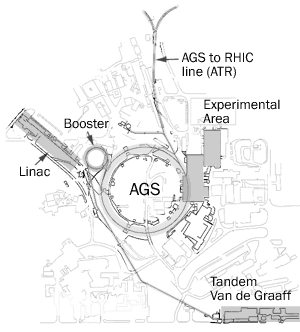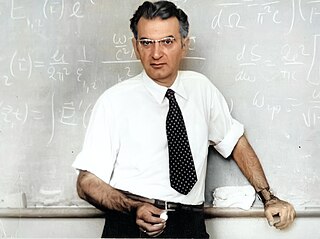Related Research Articles

Brookhaven National Laboratory (BNL) is a United States Department of Energy national laboratory located in Upton, Long Island, and was formally established in 1947 at the site of Camp Upton, a former U.S. Army base and Japanese internment camp. Its name stems from its location within the Town of Brookhaven, approximately 60 miles east of New York City. It is managed by Stony Brook University and Battelle Memorial Institute.
ISABELLE was a 200+200 GeV proton–proton colliding beam particle accelerator partially built by the United States government at Brookhaven National Laboratory in Upton, New York, before it was cancelled in July, 1983.

A synchrotron is a particular type of cyclic particle accelerator, descended from the cyclotron, in which the accelerating particle beam travels around a fixed closed-loop path. The magnetic field which bends the particle beam into its closed path increases with time during the accelerating process, being synchronized to the increasing kinetic energy of the particles. The synchrotron is one of the first accelerator concepts to enable the construction of large-scale facilities, since bending, beam focusing and acceleration can be separated into different components. The most powerful modern particle accelerators use versions of the synchrotron design. The largest synchrotron-type accelerator, also the largest particle accelerator in the world, is the 27-kilometre-circumference (17 mi) Large Hadron Collider (LHC) near Geneva, Switzerland, built in 2008 by the European Organization for Nuclear Research (CERN). It can accelerate beams of protons to an energy of 13 tera electronvolts (TeV or 1012 eV).

High-energy nuclear physics studies the behavior of nuclear matter in energy regimes typical of high-energy physics. The primary focus of this field is the study of heavy-ion collisions, as compared to lighter atoms in other particle accelerators. At sufficient collision energies, these types of collisions are theorized to produce the quark–gluon plasma. In peripheral nuclear collisions at high energies one expects to obtain information on the electromagnetic production of leptons and mesons that are not accessible in electron–positron colliders due to their much smaller luminosities.
The Rare Symmetry Violating Processes (RSVP) was a physics project terminated by the National Science Foundation, in August, 2005, originally meant for construction in the same year, at Brookhaven National Laboratory on Long Island.

The Cosmotron was a particle accelerator, specifically a proton synchrotron, at Brookhaven National Laboratory. Its construction was approved by the U.S. Atomic Energy Commission in 1948, reaching its full energy in 1953, and continuing to run until 1966. It was dismantled in 1969.
The National Synchrotron Light Source (NSLS) at Brookhaven National Laboratory (BNL) in Upton, New York was a national user research facility funded by the U.S. Department of Energy (DOE). Built from 1978 through 1984, and officially shut down on September 30, 2014, the NSLS was considered a second-generation synchrotron.

The Alternating Gradient Synchrotron (AGS) is a particle accelerator located at the Brookhaven National Laboratory in Long Island, New York, United States.
Ernest Courant was an American accelerator physicist and a fundamental contributor to modern large-scale particle accelerator concepts. His most notable discovery was his 1952 work with Milton S. Livingston and Hartland Snyder on the Strong focusing principle, a critical step in the development of modern particle accelerators like the synchrotron, though this work was preceded by that of Nicholas Christofilos.
G. Norris Glasoe was an American nuclear physicist. He was a member of the Columbia University team which was the first in the United States to verify the European discovery of the nuclear fission of uranium via neutron bombardment. During World War II, he worked at the MIT Radiation Laboratory. He was a physicist and administrator at the Brookhaven National Laboratory.
A particle accelerator is a machine that uses electromagnetic fields to propel charged particles to very high speeds and energies, and to contain them in well-defined beams.
A Fixed-Field alternating gradient Accelerator is a circular particle accelerator concept that can be characterized by its time-independent magnetic fields and the use of alternating gradient strong focusing.

The National Synchrotron Light Source II (NSLS-II) at Brookhaven National Laboratory (BNL) in Upton, New York is a national user research facility funded primarily by the U.S. Department of Energy's (DOE) Office of Science. NSLS-II is one of the world's most advanced synchrotron light sources, designed to produce x-rays 10,000 times brighter than BNL's original light source, the National Synchrotron Light Source (NSLS). NSLS-II supports basic and applied research in energy security, advanced materials synthesis and manufacturing, environment, and human health.

Milton Stanley Livingston was an American accelerator physicist, co-inventor of the cyclotron with Ernest Lawrence, and co-discoverer with Ernest Courant and Hartland Snyder of the strong focusing principle, which allowed development of modern large-scale particle accelerators. He built cyclotrons at the University of California, Cornell University and the Massachusetts Institute of Technology. During World War II, he served in the operations research group at the Office of Naval Research.
George Kenneth Green was an American accelerator physicist.
The NASA Space Radiation Laboratory (NSRL, previously called Booster Applications Facility), is a heavy ion beamline research facility; part of the Collider-Accelerator Department of Brookhaven National Laboratory, located in Upton, New York on Long Island. Its primary mission is to use ion beams (H+to Bi83+) to simulate the cosmic ray radiation fields that are more prominent beyond earth's atmosphere.

Gregory Markari (Markarovich) Garibian was a Soviet Armenian physicist, academician-secretary of the Department of Physics and Mathematics of the Armenian Academy of Sciences (AS)(1973–1991). He is known for developing the Theory of Transition Radiation and showing the feasibility of functional transition radiation detectors (TRDs). [8] [9]

Francis J. Bradley was an American health physicist, writer and founding member of the Health Physics Society.
An electron–ion collider (EIC) is a type of particle accelerator collider designed to collide spin-polarized beams of electrons and ions, in order to study the properties of nuclear matter in detail via deep inelastic scattering. In 2012, a whitepaper was published, proposing the developing and building of an EIC accelerator, and in 2015, the Department of Energy Nuclear Science Advisory Committee (NSAC) named the construction of an electron–ion collider one of the top priorities for the near future in nuclear physics in the United States.
John Paul Blewett was a Canadian-American physicist, known as "a key figure in the development of particle accelerators".
References
- ↑ "News of Science, Health Physics Society". Science. 122 (3159): 112–7. 15 July 1955. doi:10.1126/science.122.3159.112. PMID 17751437.
- ↑ Cowan, F. P.; L. B. Farabee & R. A. Love (1952). "Health Physics and Medical Aspects of a Strontium 90 Inhalation Incident". American Journal of Roentgenology and Radium Therapy. 67 (5): 805–9. PMID 14914954.
- ↑ Cowan, Frederick P.; J.S. Handloser (November 1953). "Health physics program for the Brookhaven cosmotron". BNL Report (BNL-264 CT-43).
- ↑ Cowan, F. P. (1957). "Radiation Safety in a Research Laboratory". BNL Inter-American Symposium on the Peaceful Application of Nuclear Energy. Upton, New York: Brookhaven National Laboratory.
- ↑ Cowan, F. P. (7 June 1957). "P32 Spill of April 23, 1957". Memorandum to J. B. H. Kuper (Brookhaven National Laboratory, Upton, New York): 85–87.
- ↑ Cowan, F. P.; J. Weiss (7 June 1957). "Bioassay Data and Analysis Relating to the P32 Spill of April 23, 1957". Memorandum to R. A. Love (Brookhaven National Laboratory, Upton, New York): 80–84.
- ↑ Cowan, Frederick P. (1962). "A Preliminary Report On Health Physics Problems At The Brookhaven Alternating Gradient Synchrotron". BNL Report (BNL-6001).
- ↑ Cowan, Frederick P. (1–5 April 1963). "Personnel Dosimetry of Very-High Energy Radiations". Symposium On Personnel Dosimetry Techniques For External Radiation. Madrid, Spain.
- ↑ Cowan, Frederick; Leigh F. Phillips & Robert J. King (1 July 1963). "Some Dosimetry Problems of the Alternating Gradient Synchrotron (AGS)". BNL Report (BNL 7151).
- ↑ Cowan, Frederick P. (1965). "Health Physics Program For The Brookhaven National Laboratory Synchrotrons". BNL Report (BNL-9650, CONF-651109-5).
- ↑ Cowan, F. P. (18 May 1966). "Health Physics Problems of High Energy Accelerators". BNL Report (BNL-50005).
- ↑ Cowan, Frederick P. (2009). "Everyday radiation". Physics Today. 5 (10): 10–16. doi:10.1063/1.3067365.